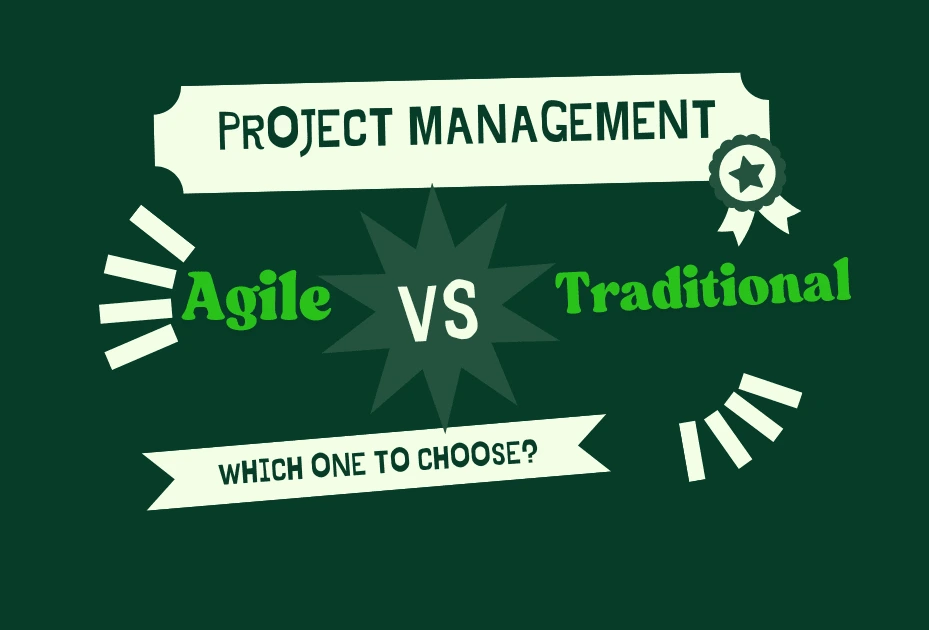The right project management style can make or break your project’s success. Yet with all the project management methods available, it is hard to decide between agile vs traditional project management.
You need to recognize the differences between traditional and agile project management in order to select the most suitable methodology for your team, timeline, and objective. Both methods have their share of strengths, one flexibility and fast iteration, and the other shines with difficulty and predictability.
Here we will discuss the main features, pros, and cons of traditional and agile project management so you can get to know them better and better understand your options. Whether you are opening a tech firm or managing large infrastructure projects, it will help you achieve easier implementation and more success when you know what type of strategy your project requires.
You May Also Like: Integration of the 5 Ps of Planning with Agile Methodologies
What is Traditional Project Management?
Waterfall or traditional project management is a sequential and linear method of managing projects. The project in this approach is decomposed into discrete, linear stages such as planning, design, implementation, testing, and delivery. Each stage has to be finished to its full extent before the subsequent stage can begin, with extensive planning at the beginning, extensive documentation, and a fixed scope.
It is also well-suited in situations where project requirements are clear and certain and are not subject to change. It provides predictability and control, and fits best in construction, manufacturing, and other such sectors where processes are conventional. Traditional project management is less flexible with regard to change as it already has a preplanned route from start to finish.
The key features of Traditional Project Management

For a comparison of agile and traditional project management, it’s essential to define the distinguishing features of traditional project management. The following characteristics define what distinguishes traditional project management:
1. Fixed Scope
Scope, objective, and deliverables in traditional project management are determined at the outset and do not change at any phase of the entire project cycle, and thus give predictability and stability.
2. Successive Stages
The project goes through distinct stages like requirements gathering, design, development, testing, and deployment, each of which is completed before proceeding to the next phase.
3. Detailed planning
Much effort goes initially into making full documentation, budgeting heavily, and considering risks in trying not to be caught off guard at some later time.
4. Defining roles
The individuals involved have delineated responsibilities and roles so as to ensure accountability and orderliness to be achieved in executing the project.
5. Poor stakeholder integration
The stakeholders will be signing off on plans at the beginning and monitoring deliverables at the latter stages, but very little in between.
The Advantages of Traditional Project Management
The traditional approach continues to be beneficial in the modern agile vs traditional approach debate for most businesses. The formality present in traditional project management possesses numerous benefits associated with it that make the approach sensible for use on those projects where predictability and control are essential.
These are the most important benefits of traditional project management, which usually make it the method of preference for some types of projects:
1. Anticipation
Classical project management possesses clear planning and timetables from the beginning, which allows for precise forecasting and minimal uncertainty during the project life cycle.
2. Control
The formal and structured methodology enables rigorous monitoring of progress, imposition of timetables, as well as effective risk management, and provides the project managers with greater control over results.
3. Documentation

Adequate record-keeping will provide properly documented references in line with legislation and also facilitate useful references for subsequent projects or audit purposes.
4. Ideal for Complex and Large Projects
The traditional approach of project management works best on large and complex projects, such as production and construction, where the requirements are set and changed less.
Though agile favors iterative delivery and flexibility, recognition of traditional method strengths in agile vs traditional project management discourse allows teams to see when a predictable and formal approach must be used in order to thrive.
Disadvantages of Traditional Project Management
After talking about agile and traditional project management, it is also important to discuss the drawbacks of traditional project management. Although its formal process guarantees control and predictability, some disadvantages are also associated with it, which can affect the success of a project, particularly in a changing environment where flexibility is a requirement.
Some of the key drawbacks of traditional project management to remember are discussed below:
1. Inflexibility
Traditional project management is crippled by an inability to respond to changes made after project initiation, and new information or shifting priorities cannot be undone.
2. Response Delays
Being sequential and linear in nature, this methodology is very slow to respond to shifting requirements or unexpected threats likely to occur during the project life cycle.
3. Delayed Value
Neither customers nor stakeholders see the product until the entire project is complete, thus depriving them of rich feedback and reducing early course correction.
An awareness of these limitations is important while making agile versus traditional project management decisions because the rigidity of traditional methods may not be appropriate for projects that require fast iteration or continuous stakeholder interaction.
What is Agile Project Management?
Agile Project Management is a speedy, iterative style that is crafted to deliver value rapidly by continuous collaboration and adaptability. Contrary to linear project management, agile splits the project into small fragments called iterations or sprints. The iteration or sprint delivers an increment of a working product, so teams get early feedback and can modify things accordingly.
Its approach is based on collaboration, customer involvement, and quick response to change. Agile is commonly applied in software development and other dynamic domains where the requirements tend to change. With its openness, flexibility, and continuous improvement, agile project management allows teams to create better-quality results that meet customers’ needs more effectively.
You May Also Like: Mastering Scrum Reporting Metrics: The Key to Agile Success
Key Characteristics of Agile Project Management
In the modern agile versus conventional project management dichotomy, agile is prominent with its flexibility and responsiveness. Agile project management is all about delivering continuous value in the form of iterative work cycles and frequent communication, which is best for those projects in which the requirements can rotate and change quickly.
The following are the typical features that render agile project management distinct from conventional project management:
1. Iterative and Incremental
Agile segments the project into small cycles known as sprints, typically 1-4 weeks long, so teams can roll out incremental enhancements on a regular basis and pivot rapidly.
2. Customer-Focused
Stakeholder involvement is central to agile, making sure that the project develops through genuine customer-driven input in real-time and indeed reacts to customer requirements during the lifecycle.
3. Flexibility
Agile allows scope change during the project life cycle, enabling teams to immediately address changes and priorities without affecting overall development.
4. Collaborative
Agile cross-functional teams of people are self-organizing and work closely together, facilitating communication and co-responsibility for project success.
5. Continuous Delivery
Functional aspects are provided in normal cycles toward the end of every sprint, providing early value and opportunities for the stakeholders to see progress on a regular basis.
6. Light Documentation
More than complete documentation, agile favors solution-oriented work and transparent communication, maintaining processes lean so the project remains continuous.
Since it outruns those characteristics, agile project management offers a fluid answer to the agile vs traditional project management dilemma, especially for projects that need to be adaptive and dynamically engage stakeholders.
Advantages of Agile Project Management

Let us discuss the advantages of agile project management that have become a popular option in most industries:
1. Flexibility
Agile supports changes at any time during the project, including in late development stages, such that the end product can be modified to meet evolving business needs and market trends.
2. Faster Feedback
With constant delivery in rapid iterations, stakeholders are continuously able to view what has been done and provide feedback on it, helping to keep the project on track early and often.
3. More Innovation
The iterative agile process encourages experimentation with things, learning from failures, and refining solutions, which fosters higher levels of innovation and creativity within the project.
4. Improved Customer Satisfaction
Uninterrupted engagement with stakeholders ensures the end product is extremely customer-need-aligned, resulting in higher satisfaction and lower chances of delivering unwanted functionality.
5. Enhanced Team Work
Agile provides cross-functional teams the liberty to interact freely and react quickly to issues, making them more efficient and team morale greater.
Understanding these advantages within the agile vs waterfall project management context allows organizations to select the most suitable approach for their requirements in terms of flexibility, speed, and customer focus.
Disadvantages of Agile Project Management
Here are some of the most common disadvantages of agile project management that should be considered when deciding if agile is best for your project:
1. Scope Creep Risk
Agile projects have frequent requirements changes and, without proper control, can invite scope creep, inefficient time, resources, and delays in responsibilities.
2. Cultural Shift Required
Going agile will require the organization to adopt a new culture dedicated to trust, flexibility, and collaboration, which are qualities some organizations cannot exercise.
3. Difficulty in Scaling
Using agile methods effectively across a large project or a large organization is challenging and would require other frameworks or coordination.
4. Less Predictability
Agile requires change and iterations; the result is unpredictable budgets and timelines as compared to more traditional lines of project management.
Being aware of these potential downsides in the agile and traditional project management matchup enables teams to be better equipped to prepare and decide if agile is best for their project and organizational culture.
Agile vs Traditional Project Management: A Side-by-Side Comparison
| Aspect | Traditional Project Management | Agile Project Management |
| Approach | Linear, sequential | Iterative, incremental |
| Scope | Fixed upfront | Flexible and evolving |
| Planning | Extensive upfront planning | Adaptive, continuous planning |
| Stakeholder Involvement | Limited to start and end phases | Continuous engagement |
| Delivery | One-time final delivery | Regular delivery of functional components |
| Team Structure | Fixed roles, hierarchical | Self-organizing, cross-functional teams |
| Documentation | Detailed and formal | Minimal, focus on working product |
| Flexibility | Low | High |
| Best Suited For | Well-defined projects with low uncertainty | Projects requiring adaptability and frequent change |
| Risk Management | Controlled and planned | Dynamic and adaptive |
| Communication | Formal meetings and documentation | Daily standups and collaborative tools |
When to Choose Traditional Project Management?
When considering agile vs traditional project management, traditional project management should be used when you have a project with stable, clearly defined requirements, and you need to strictly manage your budget and timelines. When traditional project management is used, it will lead to predictability and reduced risk, using a systematic and sequential workflow.
Traditional project management provides optimal outcomes in scenarios such as:
- Engineering and construction projects
- Manufacturing and production
- Projects requiring a high level of regulatory compliance
- Projects, contracts, and scopes that need to be strictly adhered to
- Projects involving large-scale public investment or infrastructure development
These types of projects require detailed documentation and use a predictable workflow, whereas traditional project management will provide a much lower risk option for predictable environments through project documentation.
When to Choose Agile Project Management?
When considering agile vs traditional project management, agile project management is the best project management model to use when change is constant, or customer requirements evolve quickly. Agile project management provides a collaborative approach, flexibility, early value delivery, and continued stakeholder feedback during the project.
The agile project management type is ideal when developing:
- Software development and IT projects
- Product design and innovation
- Marketing campaigns and event planning
- Projects with uncertain, changing, evolving, or poorly defined requirements
- Teams that prefer a great deal of collaboration and want fast and reliable feedback
The adaptability and flexibility necessary to improve ongoing stakeholder interactions are the reasons that agile is the best choice when stakeholder interactions are ongoing, and responsiveness to change is a large part of success.
The Hybrid Approach: Best of Both Worlds
In the ongoing battle of agile and conventional project management, every organization is finding that a blended or hybrid strategy offers the perfect structure and freedom. By combining the strengths of both methods, the hybrid model satisfies the specific needs of complex projects and diverse teams.
This approach allows teams to leverage traditional project management’s front-loaded planning and control where needed, as well as agile’s flexibility and iterative delivery, so that they can remain adaptable to change and stakeholder feedback.
What is a Hybrid Approach?
The hybrid approach combines initial planning and control of the traditional strategy with Agile’s flexibility and iterative delivery. This allows organizations to adopt a structure where necessary, but remain flexible and involve stakeholders.
When to Use Hybrid
Hybrid project management is best for larger and complex projects that involve some degree of uncertainty so that teams remain in charge while still able to adapt as necessary in implementation.
1. Moving from Traditional to Agile
For organizations making a transition away from traditional towards agile, the hybrid method provides a transitional period with established processes combined with new agile practices to minimize adoption challenges.
2. Requirements Involving Documentation
Some projects necessitate strict regulation compliance and complete documentation, which traditional methodologies make possible, but also the innovation and quick iteration that agile makes possible—so the hybrid approach is best.
3. Where Teams Use Different Methodologies
In multi-team projects, various teams might work best in the traditional organization, while some others perform optimally with agile configurations; the hybrid approach makes collaboration between such varying methodologies possible.
By intentional integration of the principles of both methodologies, the hybrid method brings about a flexible but constrained solution to most of the dilemmas of choosing agile vs traditional project management. This integration maximizes project outcomes and stakeholder satisfaction for organizations.
Real-Life Examples: Agile vs. Traditional Project Management
Example 1: Conventional Building Project
A municipal government commissions a new bridge. The scope is defined, regulations are stringent, and modifications are costly. In classic project management, the team applies a sequential step-by-step detailed plan, completes each phase sequentially, and delivers the project within budget and on time.
Example 2: Software Development (Agile)
There is a launch of a new app by a startup. Customer sentiment and market trends keep evolving at great speed. The team keeps on delivering features through Agile sprints, owing to customer feedback, and continuously iterating the product until it exactly meets market requirements.
Tips for Successful Agile and Traditional Project Management
For Traditional Projects:
- Invest time in thorough upfront planning
- Define clear roles and responsibilities
- Maintain rigorous documentation for accountability
- Manage risks proactively
- Communicate progress regularly with stakeholders
For Agile Projects:
- Foster a collaborative, trust-based team culture
- Engage stakeholders continuously
- Use tools like Jira and Trello for task management
- Hold daily standups to address issues quickly
- Be ready to embrace change and learn from feedback
- Guard against scope creep with clear prioritization
Common Misconceptions about Agile and Traditional Project Management
Myths actually hound the existence of the two methods in the agile versus traditional project management dispute. It is extremely crucial to know these myths in choosing the right method and preparing realistic project expectations for your project.
Below are common agile and traditional project management misconceptions that need to be clarified:
1. Agile Means No Planning
While commonly thought otherwise, agile is not no planning but rather continuous and adaptive planning throughout the project life cycle.
2. The Traditional Is Outdated
While as prevalent as the rage over agile has become, there will forever be projects that necessitate predictability, complete documentation, and rigid following of process, necessitating traditional project management.
3. Agile Is Chaotic
Agile methods like Scrum and Kanban provide structured and disciplined processes to keep things orderly, open, and accountable to the project.
4. The Classic Doesn’t Include Customers
Although stakeholder collaboration is not as prevalent in traditional projects as it is in agile, customers and stakeholders do become involved, primarily in initial requirement gathering and final delivery.
Eliminating such myths will equip teams to be better able to discern the advantages and disadvantages of each approach so that informed decisions may be made regarding the agile vs traditional project management dilemma.
How to Decide Between Agile vs Traditional Project Management?
Consider these key questions:
- How well-defined are the project requirements?
- How important is flexibility?
- What’s the level of stakeholder involvement?
- How much risk can you tolerate?
- Does your organization have Agile experience and culture?
The Future of Project Management
The future of project management is evolving rapidly, blending the best of traditional and agile approaches to meet the demands of increasingly complex projects. As organizations navigate the present quandary of agile or traditional project management, hybrid models that combine the structured planning of traditional methodologies with the responsiveness and flexibility of agile are becoming more popular. Technology, such as AI and automation, will ongoingly power project efficiency and collaboration, especially for remote and distributed teams. In the long term, the future favors a balanced, flexible approach where project managers borrow the best of both worlds to deliver value earlier without giving up control and predictability.
Conclusion
What it comes down to in the battle between agile vs traditional project management is not which method is better, but rather which one fits your project environment best. Traditional project management brings structure and predictability to a project and is a good fit for projects where the requirements are well-defined and stable. Agile project management brings flexibility, continuous feedback, and shorter delivery times to a project and is a good fit for projects in unstable, continuously changing environments.
By relating the big similarities and differences of project management, advantages to each type, and when to use each type, you will have a better understanding and remember the differences when it comes time to lead a project.
Today is your day to become a project management expert by using project management that fits your project environment and project goals, team environment, and customer requirements.
Did you find this guide helpful? Share your thoughts in the comments and let us know which project management style you prefer!




